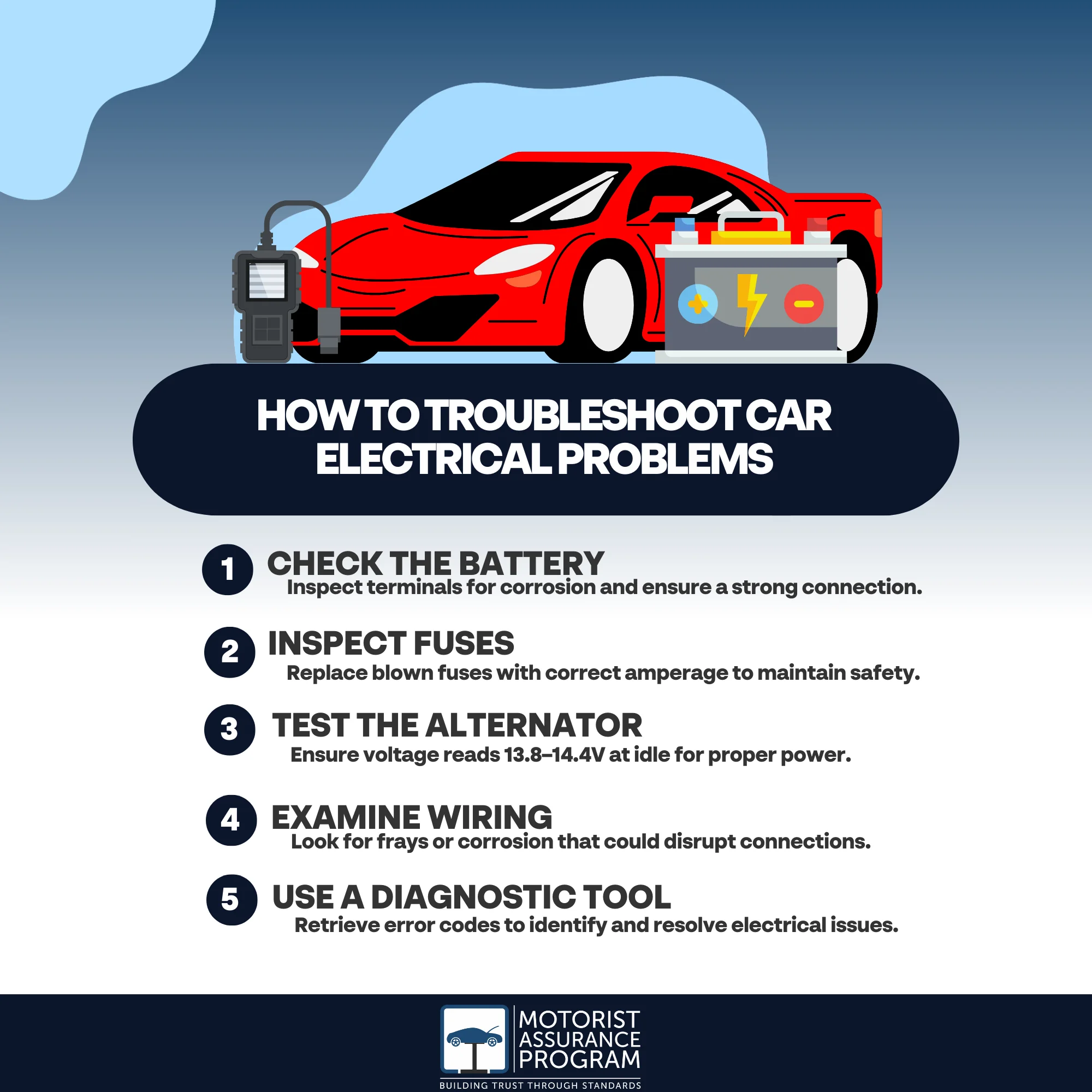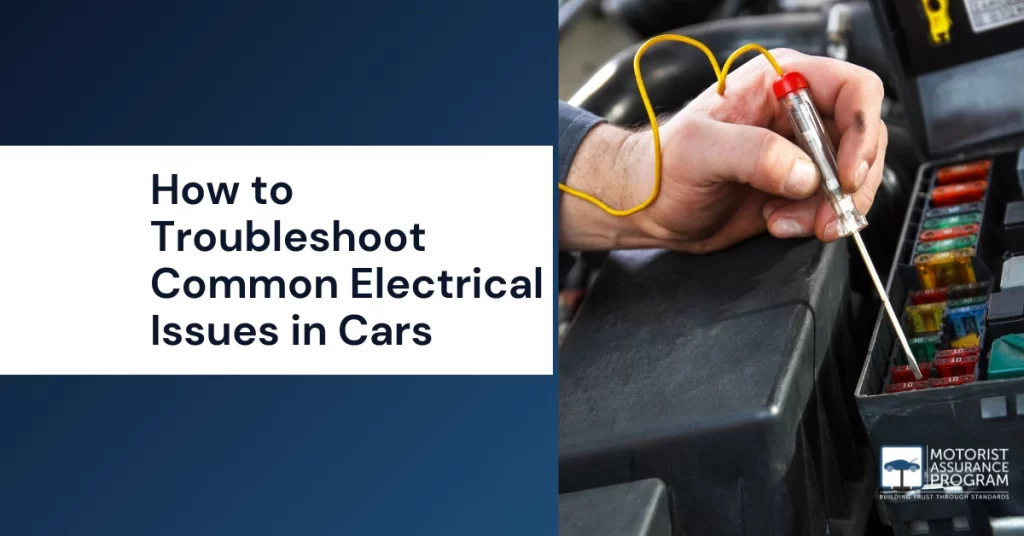To troubleshoot common electrical issues in your car, start with the battery and connections. Check for corrosion and loose terminals. Inspect fuses for any that are burnt and replace them with appropriate amperage. Next, test the alternator’s output using a multimeter; it should read between 13.8 to 14.4 volts at idle. Look for frayed wiring or signs of wear, ensuring all connections are secure and clean. Finally, connect a diagnostic tool to retrieve error codes from the onboard computer system. This proactive approach can prevent larger problems down the road, and there’s more to explore on this topic.

Key Takeaways
- Inspect the battery for corrosion and loose terminals, ensuring connections are clean and secure to prevent starting problems.
- Check the fuse box for burnt fuses and replace them with the same amperage to maintain electrical integrity.
- Test the alternator with a multimeter, ensuring it produces 13.8 to 14.4 volts at idle for proper power generation.
- Conduct a visual inspection of wiring for frays, corrosion, and moisture, addressing any damages promptly to ensure performance.
- Utilize a diagnostic tool to retrieve error codes from the onboard computer, aiding in identifying and resolving electrical issues efficiently.
Check the Battery and Connections
Checking the battery and connections is vital when troubleshooting electrical issues in your car. Start by inspecting the battery for corrosion or loose terminals. A weak battery is one of the most common electrical issues in cars, often leading to starting problems or electrical failures. Verify the battery terminals are clean and securely tightened. If the battery appears old or weak, consider testing it with a multimeter or taking it to a shop for a load test.
Next, examine the wiring and connections leading to the battery and other significant components. Look for frayed wires, loose connections, or signs of wear. These can hinder the flow of electricity and complicate diagnosing electrical problems in cars.
If you notice any signs of damage, repair or replace the affected sections to guarantee reliable electrical performance. Additionally, check for any blown fuses in the circuit, as these can also contribute to electrical failures. By addressing the battery and connection issues, you’ll be better equipped to tackle the more complex aspects of your vehicle’s electrical system. This foundational step is vital for effective troubleshooting and making sure your car runs smoothly.
Inspect Fuses for Blown Circuits
A thorough inspection of fuses can reveal critical issues within your car’s electrical system. Fuses act as safety devices, protecting your vehicle from electrical overloads that could cause damage or even fire. Start by locating the fuse box, typically found under the dashboard or in the engine compartment. Open the cover and check the diagram to identify the fuses related to the systems that are malfunctioning.
Look for any fuses that appear burnt or have a broken wire inside. These are clear signs of electrical problems in the car. If you find a blown fuse, replace it with one of the same amperage. However, keep in mind that repeatedly blown fuses could indicate a deeper electrical issue that needs professional attention.
Additionally, pay attention to any warning lights on your dashboard, as they may signal underlying electrical issues. If you notice strange behaviors like flickering lights, non-functioning accessories, or intermittent power loss, these could also be signs of electrical issues in the car. Regularly inspecting your fuses can help you stay ahead of potential problems and guarantee your vehicle runs safely and efficiently.
Test the Alternator for Proper Function
After inspecting the fuses and verifying they’re functioning properly, the next step is to test the alternator to confirm it’s generating adequate power. The alternator is vital for maintaining the battery’s charge and powering your vehicle’s electrical systems. To test it, you’ll need a multimeter. Set the multimeter to the DC voltage setting, and connect the red lead to the positive battery terminal and the black lead to the negative terminal.
Start your engine and check the voltage reading. A healthy alternator should produce between 13.8 and 14.4 volts at idle. If you see a reading lower than this, the alternator may not be functioning correctly.
Next, rev the engine slightly and observe any changes in voltage. If the reading drops markedly, this indicates potential electrical issues in cars related to the alternator.
If your alternator fails these tests, you’ll need to evaluate replacement or repair options. Knowing how to fix electrical problems in cars is essential for maintaining vehicle reliability. Regular testing of the alternator can prevent unexpected breakdowns and guarantee your vehicle runs smoothly.
Examine Wiring for Damage or Corrosion
When tackling electrical issues in your car, examining the wiring for damage or corrosion is essential. Faulty wiring can be one of the primary causes of electrical issues in cars, leading to inconsistent performance or complete system failure. Here’s how to assess the wiring effectively:
- Visual Inspection: Look for frayed wires, exposed copper, or burnt insulation. These are clear signs of wear that can lead to shorts.
- Check Connectors: Verify that all connectors are secure and free from corrosion. Corroded connectors can disrupt the electrical flow.
- Look for Signs of Moisture**: Water can cause corrosion, so check for any damp areas around wiring harnesses. Moisture often contributes to ongoing car electrical issues.
- Use a Multimeter**: Measure resistance in the wires. A high resistance reading indicates potential damage, necessitating further inspection or replacement.
Use a Diagnostic Tool for Error Codes
Utilizing a diagnostic tool to read error codes is an essential step in troubleshooting electrical issues in your car. These tools connect to your vehicle’s onboard computer system, allowing you to retrieve specific error codes that indicate what’s malfunctioning. By interpreting these codes, you can pinpoint potential issues, such as faulty sensors or wiring problems, which are common causes of electrical problems in cars.
Once you’ve gathered the error codes, you can research their meanings to understand their severity and implications. This not only aids in identifying the issue but also helps estimate how much it costs to fix electrical issues in a car. Knowing the problem allows you to discuss repairs with a mechanic confidently, ensuring you’re not overcharged for unnecessary work.
Remember that some codes may indicate multiple possible issues. As a result, a thorough investigation is vital. Using a diagnostic tool not only saves time but also empowers you to make informed decisions about your vehicle’s care. Remember, proactive troubleshooting can prevent more extensive damage and costly repairs down the line.
Frequently Asked Questions
How Can I Tell if My Battery Is Dead?
To tell if your battery’s dead, try turning on your headlights. If they’re dim or don’t light up, your battery might be weak or dead. You can also check for corrosion on terminals.
What Should I Do if I Find a Blown Fuse?
If you find a blown fuse, first verify the vehicle’s power is off. Replace the fuse with one of the same amperage, then check for underlying issues that caused the failure. Always prioritize safety during this process.
How Often Should I Test My Alternator?
You should test your alternator every six months to guarantee it’s charging properly. Regular checks prevent unexpected breakdowns and help maintain your vehicle’s electrical system, ensuring reliability and longevity in performance.
Can I Repair Damaged Wiring Myself?
You can repair damaged wiring yourself if you’ve got the right tools, knowledge, and safety precautions. Assess the damage, gather supplies, and follow proper techniques to guarantee a reliable and effective fix for your vehicle’s wiring.
What Diagnostic Tools Are Best for Beginners?
For beginners, you’ll find an OBD-II scanner invaluable. It reads error codes, helping you understand vehicle issues. A multimeter is also essential for checking voltage and continuity, ensuring you diagnose problems effectively and accurately.
Conclusion
By following these troubleshooting steps, you can tackle common electrical issues in your car with confidence. Isn’t it reassuring to know that with just a bit of knowledge, you can potentially save yourself from costly repairs? Whether it’s checking the battery, inspecting fuses, or examining wiring, each step brings you closer to a solution. Remember, a well-maintained electrical system not only keeps your vehicle running smoothly but also guarantees your safety on the road.


